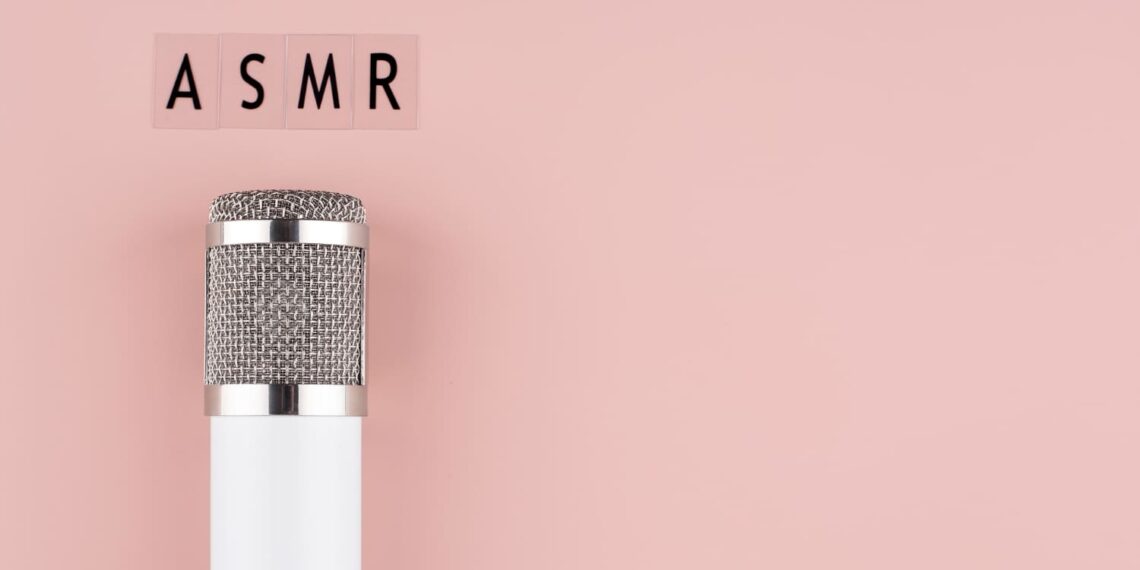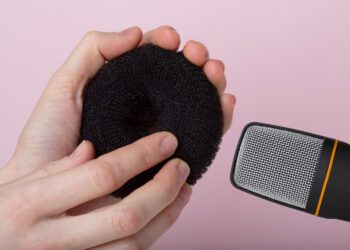Autonomous Sensory Meridian Response (ASMR) has become a popular sleep aid across the internet. If you’ve ever felt pleasant “tingles” from listening to someone whisper or gently tap on objects, you’ve experienced ASMR. Research shows that 82% of ASMR users specifically watch content to help them sleep.
But with countless triggers—whispering, tapping, brushing, crinkling—you might wonder: which works best for sleep? The short answer is that it depends on the person. However, we can explore the most popular triggers, what science says about them, and what ASMR fans report works best for falling asleep.
ASMR and Sleep: Why They Work Together
ASMR describes a soothing tingling sensation some people feel in response to gentle sights and sounds. It often starts on the scalp and travels down the neck, bringing on a wave of calm. Research suggests about one in five people are highly ASMR-sensitive, but even those who don’t feel “tingles” can still benefit from the relaxing qualities of ASMR content.
ASMR helps with sleep by reducing stress and arousal. Studies show that ASMR triggers feelings of pleasure and relaxation, releasing hormones like dopamine and oxytocin while reducing heart rate. This creates a calm, meditative state that’s perfect for sleep preparation.
In landmark research, 98% of participants said ASMR helped them relax, 82% used it for sleep, and 70% found it helpful for stress management. Dr. Lulu Guo, a sleep physician, explains that ASMR “releases negative moods” and creates the calmness needed for rest.
Despite some misconceptions, ASMR isn’t inherently sexual. Only about 5% of users report using ASMR for sexual stimulation, while 84% explicitly use it purely for relaxation and sleep.
Top ASMR Triggers for Sleep
Whispering
Whispering triggers ASMR for more people than any other stimulus. It creates an intimate, close atmosphere that many find extremely calming. The gentle, breathy quality of whispers can knock many people out within minutes.
Why it works for sleep: Whispering is naturally quiet and unobtrusive. It won’t jolt you awake but instead lulls you by keeping your focus on soft-spoken words until you drift off. Many prefer incomprehensible whispers so their brain doesn’t actively listen to content.
Potential drawbacks: A small minority find prolonged whispering too intimate or irritating. Poor microphone quality can make whispers harsh or hissy.
Soft-Spoken Voice
Similar to whispering but using gentle, quiet talking in a normal tone. Think of a librarian reading a story in a calm, low voice. Many describe this as feeling like a parent reading a bedtime story.
Why it works for sleep: The tonal qualities create a song-like rhythm that’s gentle enough not to stimulate. It provides the clarity of speech without harsh edges.
Potential drawbacks: Some very sound-sensitive people might find even soft voices too engaging compared to whispers.
Gentle Tapping
Light, rhythmic tapping on various surfaces creates repetitive sounds that can be surprisingly hypnotic. Slow, soft tapping acts like rain falling on a roof—a steady patter that soothes the brain.
Why it works for sleep: The consistent rhythm can occupy the restless part of your mind, giving you something simple to focus on while unwinding.
Potential drawbacks: Tapping is polarizing—fast or aggressive tapping can be jarring rather than relaxing. Those with misophonia might find repetitive sounds irritating.
Brushing Sounds
Gentle brushing sounds, whether from hair brushing or microphone brushing, produce soft scratching/swooshing noises. Research suggests that touch-based triggers like hair brushing tend to produce strong ASMR reactions.
Why it works for sleep: Many associate brushing with childhood memories of parents stroking their hair at bedtime. The combination of gentle sound and imagined touch can be deeply sedating.
Potential drawbacks: Some might find microphone brushing unpleasant if it’s too harsh or creates mic rumble.
Personal Attention & Role-Play
Videos where creators simulate caring for you—spa treatments, medical check-ups, hair styling, or simply providing comfort. Personal attention triggers are reported as favorites by about 69% of ASMR users.
Why it works for sleep: Being cared for makes us feel safe and relaxed. It’s like having someone digitally tuck you in, which can ease loneliness and anxiety at bedtime.
Potential drawbacks: Role-plays require some suspension of disbelief. If scenarios don’t resonate or feel silly, they might not be relaxing.
Ambient Sounds
Nature sounds like rain, wind, ocean waves, or crackling fire. While not exclusively ASMR, these sounds often accompany ASMR content or stand alone as sleep aids.
Why it works for sleep: Consistent, non-intrusive sounds mask distracting noises and provide gentle focus points. Rain, for example, acts as natural pink noise known to improve deep sleep.
Potential drawbacks: Ambient sounds alone might not trigger tingles for those seeking the ASMR sensation specifically.
What Science Says About Effective Triggers
Research identifies the most common effective triggers as whispering (75% of people), personal-attention scenarios (69%), crisp sounds like tapping (64%), and slow movements (53%).
Studies show that lower-pitched, complex sounds and slow-paced, detail-focused content work best for relaxation. Interestingly, background music in ASMR videos often inhibits the ASMR feeling for many viewers.
ASMR has been shown to reduce heart rates comparable to meditation and improve mood in 80% of users. This relaxation response is crucial for falling asleep—you need to shift into a parasympathetic (rest-and-digest) state to doze off.
Tips for Finding Your Perfect Sleep Trigger
Start with Popular Options
Begin with whispering or soft-spoken videos, which have high success rates. Try compilation videos titled “ASMR for sleep” to sample multiple triggers.
Experiment Broadly
Try different categories—pure sounds (no talking), role-plays, and ambient combinations. Pay attention to your body’s signals: tingles, relaxation, or irritation.
Consider Your Mood
Racing thoughts might need voice-based ASMR for mental anchoring, while overstimulation might call for pure sounds without verbal content.
Use Quality Headphones
ASMR works best with headphones for nuanced triggers like ear-to-ear whispers. Consider sleep-friendly headphones if you’re a side sleeper.
Set Up for Success
Lower screen brightness, use blue-light filters, and set sleep timers to avoid loud interruptions. Consider downloading videos to avoid ads that might wake you.
Try Dedicated Apps
For a curated experience without distractions, apps like Tingles offer extensive ASMR libraries with over 1000 videos, 500 podcast episodes, and 200+ trigger sounds. You can create custom mixes, set sleep timers, and avoid the interruptions that might disrupt your relaxation on other platforms.
Don’t Force What Doesn’t Work
If a trigger annoys you, skip it. ASMR should relax, not stress you. The community offers endless variety—you’ll find content matching your preferences.
Community Favorites for Sleep
ASMR fans consistently report these as top sleep triggers:
- Close-up whispering: Especially ear-to-ear whispers
- Hair play and scalp massage: Simulated or real brushing sounds
- Caring role-plays: Spa treatments, medical exams, or “grandmotherly” comfort
- Light tapping and scratching: Gentle, rhythmic sounds
- Ambient combinations: Voices with rain or nature sounds in background
Many users prefer familiar content for sleep—rewatching videos eliminates anticipation and allows deeper relaxation. Some choose ASMR in foreign languages to avoid focusing on words.
Trigger Comparison for Sleep
| Trigger | Sleep Effectiveness | Popularity | Divisiveness |
|---|---|---|---|
| Whispering | High | Very High | Low |
| Soft Speaking | High | High | Low |
| Gentle Tapping | Medium | High | Medium |
| Brushing | High | Medium-High | Low |
| Personal Attention | High | High | Medium |
| Ambient Sounds | High | High | Low |
| Mouth Sounds | Variable | Medium | High |
| Crinkling | Medium-Low | Medium | High |
Conclusion
The “best” ASMR trigger for sleep is highly personal. While whispering and personal attention rank highest in studies and community polls, your perfect trigger might be gentle rain or soft tapping. The key is the relaxation response—when you feel those eyelids getting heavy and your mind drifting, that’s ASMR doing its job.
Start with popular triggers like whispering or soft speaking, experiment broadly, and don’t worry if your preferences seem unusual. Whether it’s French whispers, dictionary readings, or space ambient noise, your ideal sleep sound is valid. The ASMR community is vast and welcoming—you’ll find your perfect lullaby.
Sweet dreams and tingly zzz’s! 😴✨
References:
- Barratt, E. L., & Davis, N. J. (2015). Autonomous Sensory Meridian Response (ASMR): A flow-like mental state. PeerJ.
- Poerio, G. L., et al. (2018). More than a feeling: Autonomous sensory meridian response (ASMR) is characterized by reliable changes in affect and physiology. PLOS ONE.
- Recent neuroimaging studies (2023-2024) confirming ASMR’s effects on brain relaxation and sleep-related regions.




